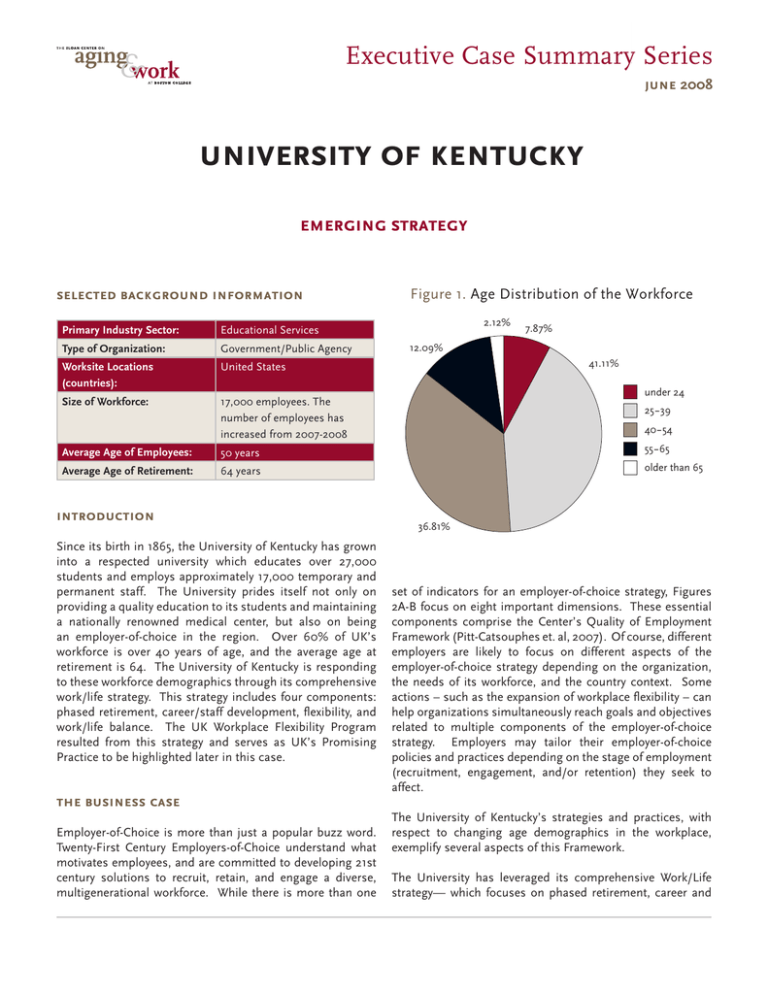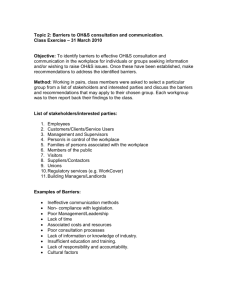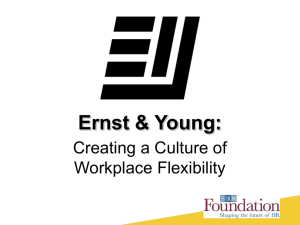university of kentucky Executive C Executive Case Summary Series emerging strategy
advertisement

Executive Case Summary Series june 2008 university of kentucky emerging strategy selected background information Primary Industry Sector: Educational Services Type of Organization: Government/Public Agency Worksite Locations (countries): United States Size of Workforce: 17,000 employees. The number of employees has increased from 2007-2008 Average Age of Employees: Average Age of Retirement: Figure 1. Age Distribution of the Workforce 2.12% 7.87% 12.09% 41.11% under 24 25-39 40-54 50 years 55-65 64 years older than 65 introduction 36.81% the business case Employer-of-Choice is more than just a popular buzz word. Twenty-First Century Employers-of-Choice understand what motivates employees, and are committed to developing 21st century solutions to recruit, retain, and engage a diverse, multigenerational workforce. While there is more than one set of indicators for an employer-of-choice strategy, Figures 2A-B focus on eight important dimensions. These essential components comprise the Center’s Quality of Employment Framework (Pitt-Catsouphes et. al, 2007). Of course, different employers are likely to focus on different aspects of the employer-of-choice strategy depending on the organization, the needs of its workforce, and the country context. Some actions – such as the expansion of workplace flexibility – can help organizations simultaneously reach goals and objectives related to multiple components of the employer-of-choice strategy. Employers may tailor their employer-of-choice policies and practices depending on the stage of employment (recruitment, engagement, and/or retention) they seek to affect. The University of Kentucky’s strategies and practices, with respect to changing age demographics in the workplace, exemplify several aspects of this Framework. The University has leveraged its comprehensive Work/Life strategy— which focuses on phased retirement, career and The Sloan Center on Aging & Work at 1 boston college Executive Case Summary Since its birth in 1865, the University of Kentucky has grown into a respected university which educates over 27,000 students and employs approximately 17,000 temporary and permanent staff. The University prides itself not only on providing a quality education to its students and maintaining a nationally renowned medical center, but also on being an employer-of-choice in the region. Over 60% of UK’s workforce is over 40 years of age, and the average age at retirement is 64. The University of Kentucky is responding to these workforce demographics through its comprehensive work/life strategy. This strategy includes four components: phased retirement, career/staff development, flexibility, and work/life balance. The UK Workplace Flexibility Program resulted from this strategy and serves as UK’s Promising Practice to be highlighted later in this case. “If you are preoccupied with personal difficulties in your life, your workplace performance and productivity may suffer. At the same time, if you are preoccupied with work, you cannot fully focus on all of your responsibilities at home. Providing flexible work arrangements is one solution to address these challenges.” Figure 2a. Quality of Employment: Strategy Opportunities for Development, Learning & Advancement -Work/Life Director Rewards; Fair, Attractive and Competitive Compensation & Benefits staff development, flexibility and work/life balance— to provide its employees with workplace flexibility and attractive and competitive compensation and benefits. Promotion of Constructive Relationships at the Workplace The University encourages its employees, particularly supervisors, to learn about implementing successful flexible work arrangements. The University of Kentucky hopes to maintain its position as an employer-of-choice by improving its ability to provide its employees with phased retirement and flexibility, as well as foster knowledge transfer. Phased Retirement Workplace Flexibility Though UK has identified workplace flexibility as an important issue, its implementation has been a challenge because it “calls for cultural change.” The University has experienced resistance from supervisors to provide flexibility. Since flexibility “means different things to different people,” UK is expecting a need for a great deal of negotiation between supervisor and employee when flexible work arrangements are being established. Knowledge Transfer Aware of their maturing workforce, UK is mindful of the importance of knowledge transfer. UK realizes it will be important that knowledge of employees nearing retirement Opportunities for Meaningful Work (at and outside of the workplace) Quality of Employment Provisions for Employability and Employment Predictabilities Workplace Flexibility Culture of Respect, Inclusion, and Equity is passed on to their replacements to make the transition as smooth as possible. The University is beginning to address how knowledge transfer is achieved most effectively, keeping in mind how employees of different generations and skill levels communicate. the response Aware of the changing demographics of its workforce, The University of Kentucky is continually making efforts to strengthen its work/life strategy. In an effort to address the previously identified challenges, UK developed a Question/ Answer tool to provide employees with tips on how to utilize, budget, and plan for phased retirement. UK hopes that this tool will help employees who have decided to utilize phased retirement but have trouble with workload reduction to do so effectively. Furthermore, UK has developed a Flexibility Toolkit and placed it on its website. This website gives UK the ability to collect narratives of flexibility success stories and post them for other employees to see. UK hopes this will encourage and help both employees and supervisors to agree to flexible work arrangements that are agreeable to both parties. Additionally, the University has launched its pilot, UK Workplace Flexibility Supervisor Training in hopes of teaching supervisors how to talk about and incorporate flexible work guidelines. This program will be the focus of the following section. 2 The Sloan Center on Aging & Work at boston college Executive Case Summary Phased retirement has been somewhat of a challenge at UK. Since its implementation, there have been numerous employees who have agreed to participate but were then unable to actually reduce their workload. The University also feels that ideally, phased retirement would provide an opportunity for succession planning, but recognizes that it does not always pan out that way. Wellness; Health & Safety Protections promising practice featured promising practice at-a-glance Figure 2b. Quality of Employment: Practice UK Workplace Flexibility Supervisor Training Description: Purpose: Two hour workshops designed to help supervisors talk to their employees about flexible work guidelines and how to effectively incorporate them into work. Opportunities for Development, Learning & Advancement Rewards; Fair, Attractive and Competitive Compensation & Benefits To promote flexibility in the workplace and help foster an understanding of why flexible work guidelines are important and how they can be successful. Target Population: Engaged supervisors organization-wide. Launch Date: April 2 & 8, 2008; April 22, 2008 for hospital side of University of Kentucky. Promotion of Constructive Relationships at the Workplace Wellness; Health & Safety Protections Opportunities for Meaningful Work (at and outside of the workplace) Quality of Employment Provisions for Employability and Employment Predictabilities Workplace Flexibility Culture of Respect, Inclusion, and Equity lessons learned The University of Kentucky was driven to develop its UK Workplace Flexibility Supervisor training as a result of the increasing popularity of flexible work arrangements, and by the realization that supervisors need more training on how to use flexible work arrangements. The UK Work/Life Survey indicated that just 25% of supervisors attended the mandatory general supervisor training, which addressed flexible work guidelines. The University of Kentucky gleaned a great deal of information from its Work/Life Survey, which justified the need for the Supervisor Training and flexible work arrangements. For example, 47% of faculty and 36% of staff agreed that the stress of establishing a balance between work and life affected their health. Furthermore, 9 out of 10 managers and supervisors believe that they have a responsibility to help employees balance work and life issues. The Supervisor Training, which consists of a two hour workshop, was piloted on April 2, 2008 and April 8, 2008. An additional workshop designed for the hospital side of UK was held April 22, 2008. The training was open to all supervisors university-wide, with preference given to those who are “engaged” and have a strong desire for additional training and learning. The workshops consisted of no more than 15 participants each. evidence of progress In addition to Supervisor Training, the Work Life Director provides individual consultations to supervisors and employees. Supervisors may request presentations tailored to their departments. After the general information on Workplace Flexibility is given, members of the department create their own guidelines for flexibility, based on the business needs of their unit. Employees are encouraged to flex their work schedules within these guidelines. The University of Kentucky plans to evaluate the effectiveness of the initial Supervisor Trainings and make appropriate revisions for future trainings. One way the pilot will be reviewed is by personal follow-up with participants after the program to discuss their thoughts. Questions may include: ÂÂ Does this workshop help supervisors understand UK’s flexible work arrangement guidelines? ÂÂ Does this workshop provide supervisors with ways to implement flexible work arrangements? ÂÂ How can the workshop be improved? 3 The Sloan Center on Aging & Work at boston college Executive Case Summary implementation moving forward Training Objectives: The University is currently working on a work/life certificate program for supervisors to further build their competence in helping their employees establish an efficient balance. They have even identified 7 areas in which they would like to do 2-hour workshops similar to the Supervisor Training. The University will carry on with its commitment to maintaining its status as an employer-of-choice by continuing to evaluate and improve upon its Comprehensive Work/Life Strategy. ρρ Understand why flexible work arrangements are important ρρ Understand different types of flexible work arrangements ρρ Learn about UK’s Flexible Work Arrangement Guidelines ρρ Discuss myths about flexibility ρρ Learn about guiding strategies for making flexibility work ρρ Learn about successful flexible work arrangements at UK Publication Date: June 2008 The Center on Aging & Work has developed the Executive Case Summary Series to provide Center Partners and members of Learning Circles with current information about workplace strategies, policies and practices established for today’s multi generational workforce. These cases have been prepared to foster the sharing of information among talent management experts and to accelerate “just-in-time” insights about employer-response to the 21st century workforce even as strategies, policies and practices are just emerging. The Case Summaries contain confidential (and in some cases, proprietary) information about organizations. Therefore, the Center provides these cases only to organizations that are Center Partners and members of Learning Circles. Interested in additional information about this Case Summary? Please contact Samantha Greenfield at 617-552-9117. Pitt-Catsouphes, M., et. al (2007). Employers-of-Choice in Countries-of-Choice (Global Executive Insight No. 01). Chestnut Hill, MA: The Center on Aging & Work/Workplace Flexibility. Retrieved from http://agingandwork.bc.edu/documents/Global01_Employer-of-Choice.pdf 4 http://agingandwork.bc.edu Executive Case Summary Case prepared by: Kathy Lynch and Serena Houle, with assistance from Lauren Sutherland, The Sloan Center on Aging & Work at Boston College





